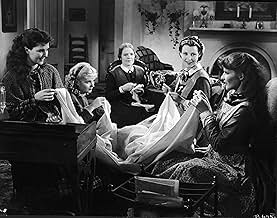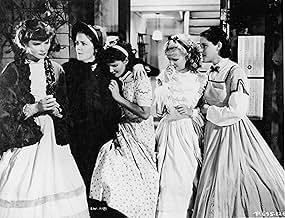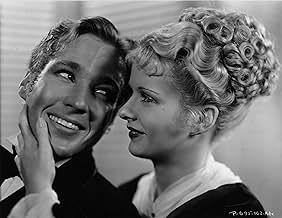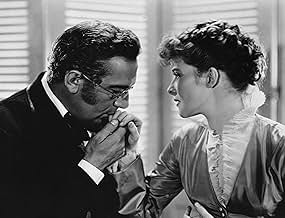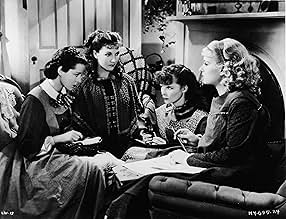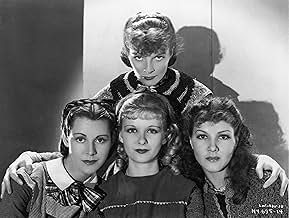NOTE IMDb
7,2/10
8,3 k
MA NOTE
Ajouter une intrigue dans votre langueA chronicle of the lives of sisters growing up in 19th-century New England.A chronicle of the lives of sisters growing up in 19th-century New England.A chronicle of the lives of sisters growing up in 19th-century New England.
- Réalisation
- Scénario
- Casting principal
- Récompensé par 1 Oscar
- 7 victoires et 4 nominations au total
John Lodge
- Brooke
- (as John Davis Lodge)
Samuel S. Hinds
- Mr. March
- (as Samuel Hinds)
Nina Borget
- Housekeeper
- (non crédité)
Francesca Braggiotti
- Dance Teacher
- (non crédité)
Luke Cosgrave
- Old Man
- (non crédité)
Avis à la une
Having grown up with the Technicolor version of the 40s with a young Liz Taylor and a perky June Allyson, I was pleased to find this was just as good a version, better in many ways. Katharine Hepburn, as you might expect, is wonderful as the tomboy Jo March, who finds responsibility after a lifetime of woe for the family. Other cast stand-outs include Edna May Oliver as Aunt March. Laurie is a bit of a wet fish though. Both early versions are much, much better than the Winona Ryder one of the 90s, which was a sentimental Hollywood nostalgia trip which just didn't work. I'm still split between the two early ones but this is a definite favourite and I'd highly recommend it.
This satisfying movie adaptation of "Little Women" features a strong cast and a production that was quite solid for 1933. While a glance at the story outline might give the impression that it is simplistic or childlike, that is far from the case. The novel offers well-defined characters and many situations that bring out worthwhile insights into the characters and into life in general. While neither this nor the other movie versions of the story have the same thematic depth, this version effectively presents enough of the material in a thoughtful and entertaining way.
Katherine Hepburn heads the cast, and gives plenty of life to Jo. Naturally she gets the main focus, but the other sisters and the secondary characters also get some good moments, and most of them get a chance to steal a scene or two. Henry Stephenson and Douglas Montgomery get a number of good scenes as the March family's neighbors. Edna May Oliver is well cast, and it's only too bad that she did not get a couple more scenes. Paul Lukas makes Professor Baer come alive. By no means least are Jean Parker, Frances Dee, and Joan Bennett as Beth, Meg, and Amy.
It is often easy to tell when the movie was made, most especially because of the sound. But actually the production is better technically and artistically than are most movies of the early 1930s. Several of the sets are particularly well done, creating just the right atmosphere for their scenes. Director George Cukor puts it all together nicely.
This is the kind of movie that is generally out of style at present, because it lacks the kind of self-indulgent material and the self-absorbed style that so unduly impress many of today's movie fans. But the only genuine weakness is that it has a few technical limitations, most of which are common to many films of its era.
What this adaptation does offer is a sympathetic and sometimes insightful look at the lives of some ordinary but strong persons, who are brought to life by a good cast and a director who seemed himself to care about the characters.
Katherine Hepburn heads the cast, and gives plenty of life to Jo. Naturally she gets the main focus, but the other sisters and the secondary characters also get some good moments, and most of them get a chance to steal a scene or two. Henry Stephenson and Douglas Montgomery get a number of good scenes as the March family's neighbors. Edna May Oliver is well cast, and it's only too bad that she did not get a couple more scenes. Paul Lukas makes Professor Baer come alive. By no means least are Jean Parker, Frances Dee, and Joan Bennett as Beth, Meg, and Amy.
It is often easy to tell when the movie was made, most especially because of the sound. But actually the production is better technically and artistically than are most movies of the early 1930s. Several of the sets are particularly well done, creating just the right atmosphere for their scenes. Director George Cukor puts it all together nicely.
This is the kind of movie that is generally out of style at present, because it lacks the kind of self-indulgent material and the self-absorbed style that so unduly impress many of today's movie fans. But the only genuine weakness is that it has a few technical limitations, most of which are common to many films of its era.
What this adaptation does offer is a sympathetic and sometimes insightful look at the lives of some ordinary but strong persons, who are brought to life by a good cast and a director who seemed himself to care about the characters.
It's always a wonderful feeling when a film works its wonders on you. LITTLE WOMEN had that effect on me, and I'm not even a fan of these types of stories. This adaptation of the Louisa May Alcott classic has real heart, warmth, and the right amount of sentimentality, amounting to a wonderful film. Katharine Hepburn stars as the tomboyish Jo, a free-spirited young lady who is dying for adventure but craves the time she spends with her sisters. The one that stands out among the four is Beth, a caring, sweet girl with a flair for the piano. If you don't get teary-eyed about her cause, you definitely pass for a curmudgeon. The only complaint I have about this gem is that the last quarter of the film doesn't seem to have the matching effervescence that the rest of the film had. It ends abruptly and off-balance. All qualms aside, this is a genuine classic, filled with great performances and characters you can't help but like. A true family entertainment. Rating: Three stars and a half.
I will always have a soft spot for this film, and to me it is the best version of the three versions I've seen so far of Little Women(1994 and 1949 were the others, and I liked both of them very much). The sound here is a little too tinny, and the Laurie of Douglass Montgommery is too fey for my tastes. However, it still looks beautiful, the costumes and hairstyles are well suited to the period, the sets are sumptuous and the film is very handsomely shot. There is also a stirring score from Max Steiner, making it sound appropriately nostalgic, the script is faithful and warm-toned, it is directed with great taste by George Cukor and the story has all the warmth and poignancy of the book, which is one of my favourites of all time. Apart from Montgommery I loved the acting, Edna May Oliver here does what she did best, more than convincingly play sharp-tongued spinsters, and Henry Stephenson is a dear Mr Laurence. Paul Lukas is an unexceptional but romantic Professor Bhaer, an improvement on the wooden and too-Italianate Rosanno Brazzi in the 1949 film, and Spring Byington a Marmee of real sincerity. The four March girls Meg, Jo, Beth and Amy(aka the Little Women of the title) are what drive the story, and all four really shone here. Joan Bennett is appealing as Amy and leaves room for character growth from a vain little girl to an elegant young lady. Jean Parker is a very sweet and moving Beth, and Frances Dee is beautiful as Meg should be. Best of all is the Jo of Katharine Hepburn, who is perfectly cast in a role she was born to play. All in all, truly lovely and the best version to me. 9/10 Bethany Cox
The film might be more accurately titled "Little Woman", with Katherine Hepburn seizing the lead role, and never letting go. Otherwise, it's the story of four "Little Women" growing up, and finding love's direction. Hepburn (she's Jo) is sister to Joan Bennett (she's Amy), Jean Parker (she's Beth), and Frances Dee (she's Meg). Of their suitors, Douglass Montgomery (he's Laurie) gets the most action.
Ms. Bennett steals the actual acting honors with a performance that is natural and consistent; her voice and mannerisms are appropriately girlish, young womanish and, selfish. Ms. Hepburn plays girlish like she's had too many cups of coffee; additionally, she never looks even remotely "tomboyish"; looking, instead, like a ravishingly made-up MGM movie star. Ms. Parker rises out of her sick bed like a zombie, but is okay in other scenes.
Watching Hepburn being romanced by Mr. Montgomery and Paul Lukas is unnerving. The story does have some reasons to watch, however. The production is obviously top-of-the-line. Hepburn may not be in her best role, but it's not awful; she slows down and gets better after her character grows older. The script has well-written characters - Jo, Amy, and Laurie - who illustrate a sweet story of family, love, and friendship.
******* Little Women (11/16/33) George Cukor ~ Katharine Hepburn, Joan Bennett, Douglass Montgomery, Paul Lukas
Ms. Bennett steals the actual acting honors with a performance that is natural and consistent; her voice and mannerisms are appropriately girlish, young womanish and, selfish. Ms. Hepburn plays girlish like she's had too many cups of coffee; additionally, she never looks even remotely "tomboyish"; looking, instead, like a ravishingly made-up MGM movie star. Ms. Parker rises out of her sick bed like a zombie, but is okay in other scenes.
Watching Hepburn being romanced by Mr. Montgomery and Paul Lukas is unnerving. The story does have some reasons to watch, however. The production is obviously top-of-the-line. Hepburn may not be in her best role, but it's not awful; she slows down and gets better after her character grows older. The script has well-written characters - Jo, Amy, and Laurie - who illustrate a sweet story of family, love, and friendship.
******* Little Women (11/16/33) George Cukor ~ Katharine Hepburn, Joan Bennett, Douglass Montgomery, Paul Lukas
Le saviez-vous
- AnecdotesKatharine Hepburn asked costume designer Walter Plunkett to copy a dress her maternal grandmother wore in a tintype photograph.
- GaffesIn the Christmas play when the prop tower falls down, Jo's lips aren't moving when she says "Everything is all right."
- Citations
Beth March: You're old enough now to leave off boyish tricks and behave better, Josephine. Now you are so tall and turn up your hair, you must remember you're a young lady.
Jo March: No, l'm not. And if turning up my hair makes me so, l'll wear it down till l'm a hundred!
- Crédits fousPaul Lukas as Professor Bher is not listed in the closing credits.
- Versions alternativesOlder video and television prints remove the original RKO logo in the opening and replace it with the one from Selznick International.
- ConnexionsFeatured in David O. Selznick: 'Your New Producer' (1935)
- Bandes originalesThe Girl I Left Behind Me
(uncredited)
Traditional
Played during the opening scene
Meilleurs choix
Connectez-vous pour évaluer et suivre la liste de favoris afin de recevoir des recommandations personnalisées
Détails
- Date de sortie
- Pays d’origine
- Langues
- Aussi connu sous le nom de
- Las cuatro hermanitas
- Lieux de tournage
- Providencia Ranch, Hollywood Hills, Los Angeles, Californie, États-Unis(exterior of March house)
- Société de production
- Voir plus de crédits d'entreprise sur IMDbPro
Box-office
- Budget
- 424 000 $US (estimé)
- Durée1 heure 55 minutes
- Rapport de forme
- 1.37 : 1
Contribuer à cette page
Suggérer une modification ou ajouter du contenu manquant


